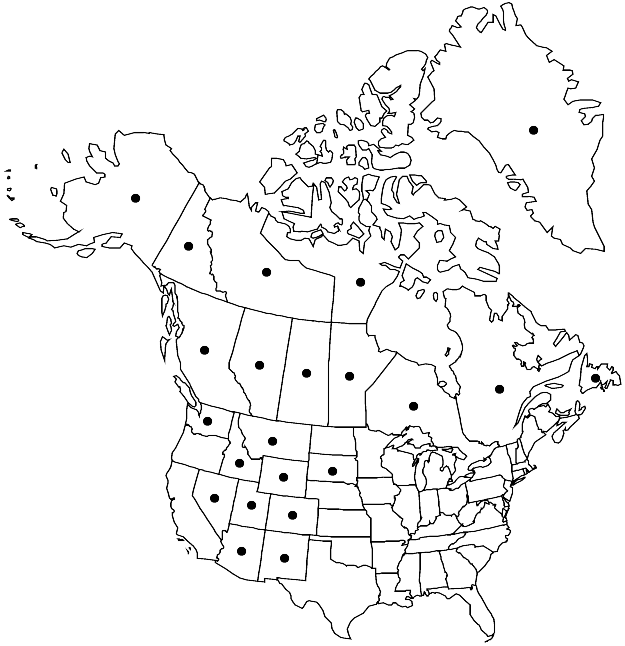Draba aurea
Fors. Oecon. Plantel. ed. 2, 599. 1806.
Perennials; (not cespitose); caudex simple or branched; not scapose. Stems sometimes branched distally, (0.5–) 1–3.5(–5.2) dm, pubescent throughout, trichomes simple (non-crisped), 0.4–1.3 mm, and 3–6-rayed ones, 0.1–0.5 mm. Basal leaves rosulate; petiolate; petiole (distinct or obscure) ciliate, (trichomes simple, to 0.8 mm); blade oblanceolate to obovate, (0.4–)1–3.7(–5) cm × (1–)2–7(–10) mm, margins entire or denticulate, surfaces pubescent, trichomes stalked, (2–)4–7 (or 8)-rayed, 0.2–0.5(–0.6) mm. Cauline leaves 5–20(–26); sessile; blade oblong to lanceolate or ovate, margins entire or dentate, surfaces pubescent as basal, sometimes adaxially with simple trichomes. Racemes (10–)18–52(–72)-flowered, usually bracteate on proximalmost 1–12(–17) flowers, rarely ebracteate, elongated in fruit; rachis not flexuous, pubescent as stem. Fruiting pedicels divaricate-ascending to ascending or suberect, straight, 3–13(–20) mm, pubescent as stem. Flowers: sepals (green or yellowish), oblong, 2.2–3 mm, pubescent, (trichomes simple and branched); petals yellow, oblanceolate, 3.5–5 × 1.5–2.5 mm; anthers ovate, 0.4–0.5 mm. Fruits (often subappressed to rachis), lanceolate to linear-lanceolate or narrowly oblong, slightly twisted or plane, flattened, (6–)9–14(–17) × 2–3.5 mm; valves pubescent, trichomes simple and short-stalked, 2–4-rayed, 0.05–0.3 mm; ovules 28–38(–44) per ovary; style 0.5–1.2(–1.5) mm. Seeds oblong, 0.9–1.3 × 0.5–0.7 mm. 2n = 74.
Phenology: Flowering Jun–Aug.
Habitat: Rock outcrops, talus, damp gullies and meadows, subalpine conifer woodlands, alpine slopes and turf, tundra, road banks, river gravel
Elevation: (0-)700-4200 m
Distribution

Greenland, Alta., B.C., Man., Nfld. and Labr. (Nfld.), N.W.T., Nunavut, Ont., Que., Sask., Yukon, Alaska, Ariz., Colo., Idaho, Mont., Nev., N.Mex., S.Dak., Utah, Wash., Wyo.
Discussion
Draba aurea is extremely variable in plant size, number of cauline leaves, number of bracteate flowers, style length, and fruit size, shape, orientation, twisting, and indumentum. Much of the variation in the number of bracts, style length, fruit twisting, and growth habit occurs in Greenland, where the type specimen was collected and where the species is found near sea level.
The highly deviant chromosome counts (e.g., 2n = 40 + 1, 64, 82) listed by R. C. Rollins (1993) and S. I. Warwick and I. A. Al-Shehbaz (2006) are mostly unvouchered and have to be disregarded; counts of 2n = ca. 80 have been re-assigned to Draba glabella. Published (G. A. Mulligan 2002) and unpublished counts made by Mulligan and M. D. Windham from Alaska, British Columbia, Colorado, Quebec, Utah, and Yukon indicate that the most common chromosome number of D. aurea is 2n = 74 (or 72). This suggests that the species is an allopolyploid (hexaploid or higher), incorporating genomes from both euploid and aneuploid lineages (M. A. Beilstein and Windham 2003). Detailed cytological and molecular studies are much needed to fully understand this widely distributed and highly variable species.
Selected References
None.